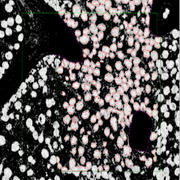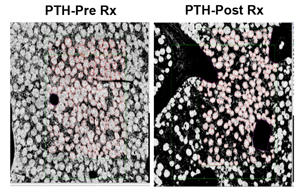
Researchers in the Lanske Laboratory at Harvard School of Dental Medicine (HSDM) in collaboration with the Rosen Laboratory at Maine Medical Center have been studying the function of Parathyroid hormone (PTH) beyond its well-known role in maintaining calcium homeostasis in the body. PTH has been approved for treatment of osteoporosis in humans to induce bone formation. Their recent finding published in Cell Metabolism reveals that PTH in addition to stimulating bone formation, prevents the occurrence of bone marrow fat.
As we age, or with certain diseases, our bones lose calcium and other minerals increasing our risk of bone fractures. This is accompanied by a change of red bone marrow into fat (becoming adipose tissue), which could further induce bone loss. PTH has been shown to influence bone formation by activating the cells that can build bone mass, and reducing the risk of fractures when it’s given to patients on a daily basis.

“This finding suggests that PTH signaling is essential in determining whether a bone marrow stromal cell differentiates into a bone or a fat cell,” Beate Lanske, HSDM professor of Oral Medicine, Infection, and Immunity said.
“The recent work from the Lanske Laboratory provides significant insight into how PTH, the only approved anabolic treatment for osteoporosis, functions at the cellular level,” Cliff Rosen, director of the Center for Clinical & Translational Research at the Maine Medical Research Institute said. “This is important because the mechanism of altering cell fate may provide a roadmap for other novel treatments for osteoporosis.”
For the first time, the bone building effect of PTH can be attributed to its ability to change cell fate. This significant finding could lead to a better understanding of how to treat osteoporosis and other diseases in humans.


